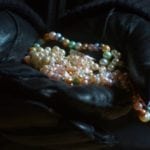 History
History  History
History  Animals
Animals Ten Times It Rained Animals (Yes, Animals)
 Mysteries
Mysteries 10 Devastating Missing Child Cases That Remain Unsolved
 Creepy
Creepy 10 Scary Tales from the Middle Ages That’ll Keep You up at Night
 Humans
Humans 10 One-of-a-kind People the World Said Goodbye to in July 2024
 Movies and TV
Movies and TV 10 Holiday Movies Released at Odd Times of the Year
 Politics
Politics 10 Countries Where Religion and Politics Are Inseparable
 Weird Stuff
Weird Stuff 10 Freaky Times When Famous Body Parts Were Stolen
 Miscellaneous
Miscellaneous 10 Interesting Things Manufacturers Stopped Making and Why
 Gaming
Gaming 10 Funny Tutorials in Games
 History
History 10 Desperate Last Stands That Ended in Victory
 Animals
Animals Ten Times It Rained Animals (Yes, Animals)
 Mysteries
Mysteries 10 Devastating Missing Child Cases That Remain Unsolved
Who's Behind Listverse?

Jamie Frater
Head Editor
Jamie founded Listverse due to an insatiable desire to share fascinating, obscure, and bizarre facts. He has been a guest speaker on numerous national radio and television stations and is a five time published author.
More About Us Creepy
Creepy 10 Scary Tales from the Middle Ages That’ll Keep You up at Night
 Humans
Humans 10 One-of-a-kind People the World Said Goodbye to in July 2024
 Movies and TV
Movies and TV 10 Holiday Movies Released at Odd Times of the Year
 Politics
Politics 10 Countries Where Religion and Politics Are Inseparable
 Weird Stuff
Weird Stuff 10 Freaky Times When Famous Body Parts Were Stolen
 Miscellaneous
Miscellaneous 10 Interesting Things Manufacturers Stopped Making and Why
 Gaming
Gaming 10 Funny Tutorials in Games
10 Impossible Heists Pulled Off By Real Thieves
Elaborate capers aren’t just the stuff of stories. Criminals really do manage to pull off complex heists that hardly seem possible. From the notorious to the accidentally brilliant, these 10 heists could rival Hollywood’s best.
10The Lilly Warehouse Raid
Police and journalists called them an Ocean’s Eleven–style gang, but the Villa brothers targeted warehouses of prescription drugs, not casinos. On March 13, 2010, they cut through the roof of the Eli Lilly warehouse in Enfield, Connecticut, lowered themselves in, and cleaned house to the tune of $80 million.
The gang defeated the warehouse’s security using an insider’s advantage—they had a security report detailing the warehouse’s every weakness. Plus, one crew member had scouted the warehouse three months prior to the heist. The crew found the softest part of the roof, parking space for the getaway truck, and even the surveillance camera’s blind spots.
But a few carelessly discarded items brought them down. They left a new set of Husky tools, and they’d been caught on security cameras buying those tools the previous night. Amed Villa also left a water bottle with his DNA, letting police further link him to three earlier robberies.
On top of the DNA and video evidence, customs agents intercepted packages of medicine labels the thieves had ordered to sell their drugs on the black market.
9Picasso’s Granddaughters

Art historian Diana Widmaier Picasso is the daughter of Picasso’s daughter Maya. In her Paris apartment hung a portrait of her mother, Maya with Doll, painted by her famous grandfather.
In February 2007, as Diana and a friend slept, bold thieves broke in. They swiped the portrait of Maya, a drawing, and a portrait of Picasso’s second wife, Jacqueline. They cut out Portrait of Jacqueline and lifted Maya with Doll, frame and all. They escaped without leaving a trace of evidence.
The theft was thought to be ordered by a wealthy private collector because the two paintings are estimated to be worth more than $66 million dollars at auction. But police had no idea how the thieves got in, why the alarm system hadn’t sounded, or how thieves knew exactly where the paintings were in Diana’s apartment. They had no leads, until a suspicious dealer called in a tip that August. Police tailed three men for over a month and caught them trying to sell the stolen art.
As bad as the theft may have been, Diana wasn’t the first Picasso granddaughter to be robbed. Marina Picasso’s villa in Cannes, France was burglarized in November 1989. Thieves stole more than $17 million worth of art that night, including seven Picasso paintings. Here, too, the alarm didn’t work, and five guard dogs made no sound.
8The Cash Depot Landing
Every 25th of the month, most Swedish employees get their monthly paycheck. ATMs see a rush on the 25th, so in the days immediately prior, the cash depots that supply ATMs are stocked and ripe for robbery. One crew planned to hit a depot in September 2009, and they wanted a quick getaway. Their well-executed plan hinged on first swiping a helicopter.
The whole heist, caught on tape, took less than 30 minutes. Footage shows three masked men jumping out of the helicopter, blowing a hole in the roof, and then climbing down into the depot with ladders. Once inside, they cut off cage locks and stuff their bags with wads of cash. After climbing up, they load the helicopter and fly off, $5.3 million richer.
To keep authorities busy, the thieves further planted a bag, clearly marked “BOMB,” in the police heliport. The bomb squad had to disarm the device before they could access their own helicopter. Metal spikes also blocked roads leading to the depot to delay police response.
The crew’s celebration was short. Police arrested a suspect within hours. In all, 10 gang members were sentenced, with the ringleaders receiving a seven-year sentence. Swedish Police had actually been tipped off about the heist but were unable to identify the target in time.
But one mystery remains. Though police recovered some of the money, nearly all of it disappeared.
7Antwerp’s Friendly Jewel Thief

Carlos Hector Flomenbaum was a friendly guy. For a full year, he was a trusted customer at ABM Amro bank, kind enough to bring chocolates to the regular staff. Too bad that was all a front to gain the trust and keys of some unsuspecting bankers.
Belgium is a favorite destination for diamond thieves. With more than half of all diamonds in the world passing through Antwerp and air shipments leaving through Brussels, it’s like Candyland for jewel thieves. Carlos operated as a diamond trader, doing the opposite of what most thieves do. Carlos Flomenbaum made sure bankers saw him; he stuck out intentionally. And in the process, the 183-centimeter (6’3″) charmer in his late fifties swiped $28 million worth of diamonds, weighing 120,000 carats.
The bank had been fitted with a million-dollar security system, but elaborate security systems don’t help much when you give the thief a key. Employees gave Carlos an electric key card to access his own supposed stash of diamonds. He used that vault key to enter and loot several legitimate traders’ safe deposit boxes.
The duped bank employees at ABN Amro Bank in Antwerp still can’t believe ol’ Carlos used the key they gave him to steal everyone’s diamonds. And it turns out that “Carlos” wasn’t even his real name—police discovered that his “Carlos Flomenbaum” passport had been stolen from Israel years before.
The man hasn’t been seen since the robbery.
6The Carnival Caper

Brazil’s annual Carnival is one of the best parties in the world. It’s also a great time to disappear into the crowd with stolen Matisse and Monet art grabbed right off the wall.
In February 2006, four men waited patiently in line and paid for entry into Rio’s Chacara do Ceu Museum. It was just before closing time on the Friday night during Carnival celebrations, and the men seemed like eager visitors. Once near the galleries, the thieves whipped out guns and ordered visitors and guards to pile into the security office. The robbers also flashed a grenade to terrify hostages. They forced security staff to disconnect an alarm and cut cameras. With hostages bound and gagged, the crew went on their own art tour.
The quartet grabbed four paintings by Monet, Matisse, Picasso, and Dali worth $50 million. For good measure, they robbed the museum visitors and stole security tapes. One brave security guard just arriving tried to wrestle the bandits to the ground, but they pistol-whipped him. They then beat a quick path through the woods and used the frenzy of Carnival to disappear toward accomplices waiting in a van.
This robbery remains on the FBI Top 10 Art Crime list.
5The Real-Life Italian Job

In February 2008, Milan police received a call from a woman who said mysterious drilling was disturbing her sleep. They dismissed her concerns. There was some renovation work in the area, and they could do nothing about it. No one noticed that the renovated building connected to a Damiani jewelry showroom.
On a quiet Sunday morning soon after this, four men dressed like policemen emerged in the showroom. No one realized it at the time, but the men had drilled through the basement’s 1.2-meter (4 ft) wall, bypassing all security. The thieves tied up the employees, shoved them in a room, and forced one hostage to open the safe. They scooped up gold and gems and swept out.
Lucky for Damiani, the most valuable pieces were in Los Angeles that weekend for the Oscars. Damiani had also sent a collection to Tokyo for the opening of a new boutique. The company lost only $7.5 million in insured stones.
4The Manager’s Holdup

In April 2009, 50-year-old veteran Bank of Queensland manager John Thomas Forrester walked into his branch and robbed his own bank. Why? Poison.
According to the Forrester, he was just a pawn. Irish anarchists had jacked his car and injected him with poison while he was on his way to work. They gave him an ultimatum: Rob the bank or die. If he pulled off the heist, they’d give him the antidote to the poison. And just in case his own death weren’t threat enough, the criminals told him a bomb would explode in the branch if he failed.
So Forrester walked into the bank and then walked out with AUD 40,000. He dropped off a backpack with the cash as instructed and awaited further word. None came.
Police ordered a blood test to determine if Forrester had ever been poisoned, but it gave no definite answers. The man did have telltale injection marks on the back of his neck, and police found his car, presumably discarded by someone else. Defense lawyers accused the police of a bungled investigation, and a magistrate described John Forrester as a “saint.” Prosecutors, however, claimed that the manager had invented the crazy story.
Forrester was found not guilty and returned to work in November 2011. Police never recovered the money.
3Mexico Museum Heist

Christmas is a time for giving, and on Christmas Eve 1985, one crew of thieves did plenty of receiving. The gang helped themselves to precious pre-Columbian artifacts from the Mexico City Museum, including a jade Mayan mask and other spoils from a king’s tomb. They sneaked in and silently opened seven display cases containing the goods. They then destroyed the wooden moldings and then lifted the glass panes. Ninety-nine of the valuable pieces were made of gold.
The museum had eight guards and a police supervisor on duty that night but lacked an electric alarm due to recent security upgrades to the display room. The guards must have spent all night partying because no one discovered the missing objects until morning.
Fortunately for the museum, the thieves weren’t as skilled as they first seemed. Carlos Perches Trevino and his partner, Ramon Sardina Garcia, hadn’t worked out how to profit from the theft. They just held the artifacts in a suitcase and tried but failed to sell the lot to drug traffickers. They exchanged only a couple of them for cocaine to one trafficker, Salvador Gutierrez, and when police picked the man up, he led them to the thieves. Police found 111 of the 124 pieces in Trevino’s apartment.
2The Concert Robbery
Justin Bieber may steal hearts, so perhaps it’s only fair that others steal his money. The star performed in Johannesburg in May 2013, one night after Bon Jovi played in the same stadium. Before any of cash from the shows could be removed from the stadium, a crew of thieves chiseled their way from a bathroom to the stadium’s safe room. Police estimate that it took about three days to finish all stages of the crime. It also took nerves of steel to come back each night in a stadium full of employees.
After breaching the wall, the team used a rope system to drop into the room undetected. The thieves left the safe room empty besides the debris and bricks from their chiseling. Officials didn’t even miss the money until Monday morning. Once they did, stadium management suspected an inside job due to the specific knowledge needed.
Employees had to take polygraphs, and the stadium was locked down. Investigators collected fingerprints and footprint casts at the scene. They looked into more than 4,000 temp workers associated with the stadium without coming up with anything.
The gang made off with 3 million rand, or about $330,000, in cash.
1The Vanishing Femmes

A wealthy collector buys a famous Picasso piece for his eyes only. Precious few friends know that he even owns it. He doesn’t show off his purchase. He hides it when he has guests. The likelihood of the bust being stolen is low. The masterpiece stays in a locked, alarmed room on his massive yacht. So how does Buste de Femme 1938 vanish from his ship? Art Pirates.
In March 1999, the mystery collector had his floating paradise scheduled for maintenance. He took precautions. His personal art curator was called in to pack and store the painting. The yacht held art collectively worth more than £151 million.
The painting was vulnerable at this moment. It was no longer rigged with an alarm and was packed, awaiting transport. The surveillance system on the dock was also conveniently down for maintenance. Somewhere between the final packing and the pickup for storage, art pirates struck. When the art expert returned, Buste de Femme 1938 had vanished.
A few weeks later, another Picasso work depicting Dora Maar disappeared from Paris. Dora was also the model for Buste de Femme 1938. The theft of two Picasso works specifically modeled after Dora suggests that the heists were connected and the work of a gang who stole paintings to order. Neither work has been recovered.
Kacey is a freelance writer and blogger. She is an avid traveler and film buff who specializes in SEO, travel, blogging, copywriting, and other business writing. In her downtime, she writes poetry, watches House Hunters and dances like no one is watching. She blogs about less illegal ventures (most of the time) at DreamersLoft.org.








